Fresno Air National Guard Base
| Fresno Air National Guard Base Fresno Air Terminal Air Guard Station Hammer Field | |
|---|---|
| Part of California Air National Guard (CA ANG) | |
| Located near: Fresno, California | |
|
F-16s of the California Air National Guard's 194th Fighter Squadron, 144th Fighter Wing over San Francisco. | |
| Coordinates | 36°46′34″N 119°43′50″W / 36.77611°N 119.73056°W |
| Site information | |
| Controlled by |
|
| Site history | |
| Built | 1942 |
| In use | 1942-Present |
| Garrison information | |
| Garrison |
 144th Fighter Wing |
| Airfield information | |||||||||||||||
|---|---|---|---|---|---|---|---|---|---|---|---|---|---|---|---|
| IATA: FAT – ICAO: KFAT – FAA LID: FAT | |||||||||||||||
| Summary | |||||||||||||||
| Elevation AMSL | 336 ft / 102 m | ||||||||||||||
| Coordinates | 36°46′34″N 119°43′50″W / 36.77611°N 119.73056°WCoordinates: 36°46′34″N 119°43′50″W / 36.77611°N 119.73056°W | ||||||||||||||
| Website | www.144fw.ang.af.mil | ||||||||||||||
| Map | |||||||||||||||
 KFAT  KFAT Location of Fresno Air National Guard Base | |||||||||||||||
| Runways | |||||||||||||||
| |||||||||||||||
| Helipads | |||||||||||||||
| |||||||||||||||
Fresno Air National Guard Base is the home base of the California Air National Guard 144th Fighter Wing.[1]
Overview
The Fresno Air National Guard Base in California is home to the 144th Fighter Wing. The 144th Fighter Wing (FW) of the California Air National Guard occupies two separate parcels of land (the main base area and the Munitions Storage Area) totaling 110.726 acres (0.44809 km2) of leased land on the Fresno Yosemite International Airport (formerly named Fresno Air Terminal), located approximately 4 miles (6.4 km) east of downtown Fresno, California.[1]
Operationally gained by the Air Combat Command (ACC), the mission of the 144th FW is to provide air defense protection for California from the Mexican border to Oregon utilizing F-16 Fighting Falcon aircraft. The 144th FW occupies six administrative, 16 industrial and two services buildings totaling approximately 341,251 square feet (31,703.3 m2) with 325 full-time personnel, primarily Active Guard and Reserve (AGR) and Air Reserve Technician (ART) personnel. A unit training drill is conducted once a month and results in a surge of up to a total of 990 personnel when "traditional" part-time air national guardsmen are included. The part-time personnel, particularly pilots, also perform additional drills, additional flying training periods and/or additional active duty every month throughout the year.[1]
The Composite Support Facility, completed in late 2001, added an additional 6,236 sq ft (579.3 m2) of building area. The 144th FW occupies 6 administrative, 16 industrial and 2 services buildings totaling approximately 341,251 square feet (31,703.3 m2) with 325 full-time personnel. A unit training drill is conducted once a month and results in a surge of up to a total of 990 personnel. There is currently an ongoing construction project (Composite Support Facility), which when completed by the end of FY 2001, will add an additional 6,236 square feet (579.3 m2) of building area.[1]
In addition, the 1106th Theater Aviation Sustainment Maintenance Group (formerly the 1106th Aviation Classification and Repair Depot) is located at Fresno. It includes hangar facilities, aircraft parking aprons, and armories. The 1106th AVCRAD's mission was to provide aircraft support to the National Guard's aviation units of thirteen western states. It performs the highest level of maintenance possible on Army aircraft.[1]
History
Hammer Field, Fresno County, Fresno, California, also known as Fresno Air Base and previously known as Fresno Air Field and Municipal Airport at Fresno, was located 5 miles (8.0 km) northeast of Fresno. The Army Air Force acquired this area for the Airways Detachment to set up a sub-base of Camp Pinedale for an extension of ordnance storage facilities and additional land for housing construction, an Army Air Forces regional hospital, laundry, drainage facilities, cold storage, fire station, school building, rifle ranges, high tower shot gun range, motor pool areas, chemical warfare storage area, a concrete underground igloo magazine arms storage.[1]
Known Army Air Force units at Hammer Field were:
- 84th, 85th, 86th, 97th Bombardment Squadron (Light)
- 15th Air Force, 456th Bomb Group, 745th Squadron, 15th Crew (B-24 Bombers)
- 15th Air Force, 461st Bomb Group, 764th Bombardment Squadron (H) (B-24 Bombers)
Night Fighter Training
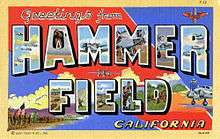
On 1 January 1944, the Army Air Forces Night Fighter School was reassigned from the Army Air Forces School of Applied Tactics at Orlando Army Airfield, Florida to IV Fighter Command. The 481st Night Fighter Operational Training Group (NFOTG) was moved to Hammer Field on 30 January.[1]
The group operated a combination of modified Douglas A-20 Havocs for night fighter operations, designated P-70, and brand-new prototype YP-61 Black Widow purpose-built night fighters manufactured by Northrup in Hawthorne, California.
Along with the headquarters and main base at Hammer Field, other auxiliary fields used by the 481st NFOTG operated from:
- Salinas Army Air Base 36°39′46″N 121°36′23″W / 36.66278°N 121.60639°W
- Delano Army Airfield 35°44′44″N 119°14′11″W / 35.74556°N 119.23639°W
- Meadows Field 35°26′01″N 119°03′24″W / 35.43361°N 119.05667°W
- Visalia Army Airfield 36°19′07″N 119°23′34″W / 36.31861°N 119.39278°W
- Hayward Army Airfield 37°39′33″N 122°07′20″W / 37.65917°N 122.12222°W
The 348th Night Fighter Squadron was the Operational Training Unit (OTU) under the 481st which provided instructional training to new pilots. Newly manufactured aircraft were transferred from Northrup at Hawthorne to the newly formed operational squadrons at Hammer Field prior to their deployment to the overseas combat theaters.[1]
When the school moved from Florida, the 425th Night Fighter Squadron was in training at Orlando AAF. It was reassigned initially to Hammer Field on 30 January 1944, and was further reassigned to Visalia AAF on 25 February. It eventually was deployed to England in May.[1]
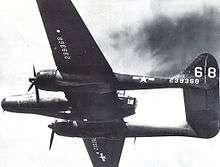
Night Fighter Squadrons which were formed and/or trained at Hammer Field were:[1]
- Formed January 1944 at Hammer Field, moved to Delano for training in March. Deployed to Tenth Air Force in the CBI
- Formed February 1944 at Hammer Field, moved to Bakersfield for training in May. Was programmed for assignment to the Soviet Union to protect USAAF bases in the Ukraine as part of Operation Frantic. Instead was assigned to the CBI.
- Formed March 1944 at Hammer Field, moved to Visalia for training in May. Deployed to Thirteenth Air Force in the Philippines.
- Formed April 1944 at Salinas Army Air Base, moved to Delano for training in June. Deployed to Seventh Air Force in the Mariana Islands for protection of B-29 Bases
- Formed May 1944 at Hammer Field, moved to Bakersfield for training in June. Deployed to Seventh Air Force in the Mariana Islands for protection of B-29 Bases
- Formed June 1944 at Hammer Field, moved to Visalia for training in August. Deployed to Fifth Air Force in New Guinea.
With the 550th NFS deploying to the Pacific in December 1944, the 481st NFOG was inactivated. It was replaced by the 450th Army Air Forces Base Unit (AAFBU), and the mission of Hammer Field and the Night Fighter Training School became Replacement Pilot Training (RTU). The 450th was made up of a number of lettered squadrons, which were expressed as the 450th AAFBU (A Squadron), and so on. These replacement training squadrons operated at the same airfields as was used by the 481st NFOG in the San Joaquin Valley. The 441st AAFBU provided gunnery training from Van Nuys Airport in the San Fernando Valley and the 403d AAFBU at Hammer Field provided ground training for support personnel. All of these Army Air Force Base Units were under the operational control of the IV Fighter Command 319th Wing, headquartered at Hammer Field.[1]
The 319th Wing concluded its training of replacement pilots in May 1945 and operations at the airfield were phased down to a standby status. The 319th was moved to San Francisco in September 1945 taking over the air defense mission of the San Francisco Air Defense Region.[1]
Fresno Ground Training Center
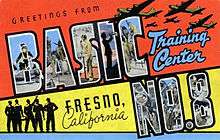
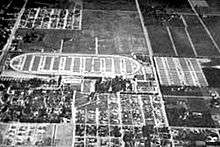
About ten miles northwest of Hammer Field, the United States Government opened a relocation camp for Japanese-Americans in May, 1942 at the Fresno County Fairgrounds. Open from May until October 1942, the camp held about 5,000 persons from the central San Joaquin Valley and Amador County. It consisted of about 100 buildings for housing the Japanese-Americans and other buildings made primarily of wood and tar paper. The people at the camp were later sent to more substantial facilities at the Relocation Center at Jerome, Arkansas.[2]
The facility was then turned over to Fourth Air Force which converted it into a non-flying facility called the Fresno Ground Training Center. It was subsequently transferred to the Western Technical Training Command (WTTC) and used for training of Signalmen, camouflage specialists, chemical warfare specialists, ordnance technicians, clerks, truck drivers and cooks. It was also used as a Basic Training Center for new enlistees, designated as Basic Training Center No. 8. It was closed with the end of World War II in the fall of 1945.[2]
Postwar use
With the end of the war in September 1945, Hammer Field was inactivated and was disposed of though the War Assets Administration (WAA). By 1949 the facility was completely in civil hands; the sources included the city of Fresno (804.59 acres by lease), 21 individual landowners (781.96 acres by fee and 27.24 acres (11.02 ha) by lease), easement right-of-ways (1.42 acres) and permit (1.64 acres). In 1943, the lease on 9.24 acres (37,400 m2) was terminated. In 1945 and 1946, the leases for 18 acres (7.3 ha) and 5 acres (2.0 ha) were terminated, respectively. Effective January 15, 1947, 23.06 acres (9.33 ha) were reassigned for the Hammer Field National Guard training area. In 1948, 319 acres (129 ha) were quitclaimed and the lease on 799.69 acres (323.62 ha) was transferred to the city of Fresno. In 1948 and 1949, 441.5 acres (178.7 ha) were quitclaimed to the state of California.[1]
In 1945 and 1946, the leases for 18 acres (73,000 m2) and 5 acres (20,000 m2) were terminated, respectively. Effective January 15, 1947, 23.06 acres (93,300 m2) were reassigned for the Hammer Field National Guard training area. In 1948, 319 acres (1.29 km2) were quitclaimed and the lease on 799.69 acres (3.2362 km2) were transferred to the City of Fresno. In 1948 and 1949, 441.5 acres (1.787 km2) were quitclaimed to the State of California.[1]
References
![]() This article incorporates public domain material from the Air Force Historical Research Agency website http://www.afhra.af.mil/.
This article incorporates public domain material from the Air Force Historical Research Agency website http://www.afhra.af.mil/.
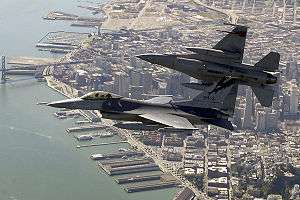
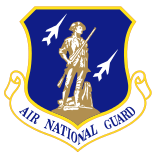
.svg.png)